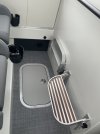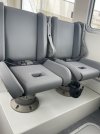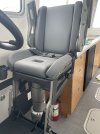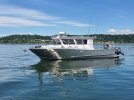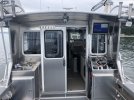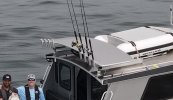Just saw this thread, congrats! I just went thru the build process on my 35' x 11' Coldwater (same boat as
@TomicTime but a bit smaller and Yami F300 outboards instead of twin diesel).
Here are my quick observations after 1.5 years of ownership. No opinions are wrong -- this is YOUR boat so whatever you chose is the RIGHT decision for you. Didn't read every detail of each post, so perhaps some of this is already discussed/irrelevant, but here goes...
Motors -- IMO more power is better. I have twin F300's and the boat cruises @ 25-28kt 4500RPM 0.9-1.1 statute mpg. Max speed is 37kt @ .7 mpg. Power is decent, gets on step no prob, though will fall off if under 23kt. In hindsight I wish I had gone with twin 425's so I could lower cruise RPMs, planing speed, power when needed (climbing backside of 5'-6' waves in following seas is pucker moment with twin 300's) and most importantly do on the water low unit fluid changes. Oil changes are easy on the water and cheap -- $200 USD OTD -- so triples would've been OK too. Yeah, there's more maintenance (filters, impellers, plugs, etc) but if you do it yourself the costs aren't bad at all going from twins to trips.
Fuel costs - You burn more fuel, but at this boat's price point you probably care less than about that than others. I burn ~3000 gallons over the entire year, and I fish a TON during the summer and long ranges too - avg daily trip is 20-40 miles round trip with a few 200+ mile trips in the mix. The annual boat cost is less than taking family for a single cross-country resort vacation for a week so relatively speaking boat costs peanuts for how much happiness, flexibility, and stress relief it gives me. Zero regrets thus far, only going to continue using it more.
Burnewiin's - They are AWESOME. The downrigger mounts are expensive but well worth it. I can disconnect in 2 seconds and stow in cabin to avoid theft and keep them out of the elements. You will need stainless mounts for the downriggers, which means you will want to make sure the builder is minimizing contact with the aluminum (dissimilar metal corrosion will happen quickly). The burnewiin plastic spacers don't help much -- add more if you can.
Consider adding an inverter. It's amazing how many times I want to run a microwave on the troll or anchor or use a chest freezer on longer trips. I pack a Honda gen (2200) but it's a pain lugging around and dealing with. I'm currently in the process of adding a 3K watt pure-sine inverter now, wish I had opted this in during the build.
Maximize your tank size. Range becomes an issue not only for the ability to reach the fishing grounds but also allows you to skip fuel stops where it is more expensive. No more having to come in early to hit the fuel dock before closing. It's funny how much you forget about fuel burn the less you fuel up. bigger tank == newfound freedom.
Make sure you have flexibility in adjusting the ballast to keep the boat level under all dynamic circumstances (ice, fish, folks standing in cockpit vs cabin, etc). Add freeman/fraser METAL hatches (not plastic!!) to the pod or as far aft as possible so you can put all your heavy stuff back there if you want (lead, tools, especially). Consider moving the fresh water tank further aft if necessary so you can level boat by adding water. You're gonna need freshwater anyway so might as well use it to your advantage. Make the freshwater tank as large as possible for this purpose.
Rear helm on port or starboard? Think about this carefully. On a larger boat, if you have a preferred side where YOU like to fish, consider putting the helm on the same side. I made this mistake. I fish on the port side since the kicker is there and I don't want my newbie guests following the prop with their gear, however I put the help on the starboard size. This adds ~2 extra feet to walk to adjust speed, etc on the troll and the rear plotter is that much further away.
Corrosion. You have a lot of external paint, consider not painting and using a combination of bare aluminum (protected by Sharkhide) and a vinyl wrap. Wraps are cheap and you can replace them in a day or two and change colors. Mine looks amazing today and zero peeling. All those stainless fasteners and bolt ons (e.g. burnewiin) will bubble the paint in short order. Make sure all screws have silicone on the threads to lessen (but not prevent) corrosion. Make sure ALL contact between sinks, helms, faucets, etc have a plastic/vinyl/plexiglass/etc spacer (not rubber -- it will degrade) to minimize effects.
Add extra USB/12V connections throughout boat. Phones, laptops, CPAP's, etc -- it seems they never are used where the connections are.
Joystick vs. bow thruster. I chose bow thruster. The joystick was very expensive (25K), looks like it is very hard on the motors, loud, etc and just another system that will fail with all the mechanical/hydraulic effort involved. You can easily manuever around the docks with twins and bow thruster after a bit of practice. Leave motors straight, hands off the wheel, just work the throttles to pivot boat, tap thruster only for slight adjustments to counter wind/drift. Super easy, I'm glad I didn't get the joystick.
Add a kicker. I run a Yami T25 fuel-injected kicker with my twin F300's. Saves fuel, keeps hours off main, pushes boat just fine. As mentioned by others, reverse is useless on a boat this size. In hindsight I should've gotten a 50hp for the extra responsiveness turning into the wind or putting guest broadside to their fish but 25HP gets it done.
FLIR M232 or MD625. Go with the Md625 -- only a few hundred bucks more and twice the resolution. Well worth the upgrade for greater definition.
suggest adding kick plates where folks' boots/shoes will scuff the interior paint. My builder added 1/4" clear plexiglass everywhere needed and it works great -- easy to wipe off all those black marks.
Use sharkhide everywhere you have exposed aluminum, and before you dunk the boat. This stuff works very well. And consider sharkhiding the bilge or wherever fog and humidity will reach. All that condensation will just leave salt deposits, so you really only get one good chance to do this before the effects begin.
Again, just my personal opinions. Hope this helps.
Best of luck!
-Barry

